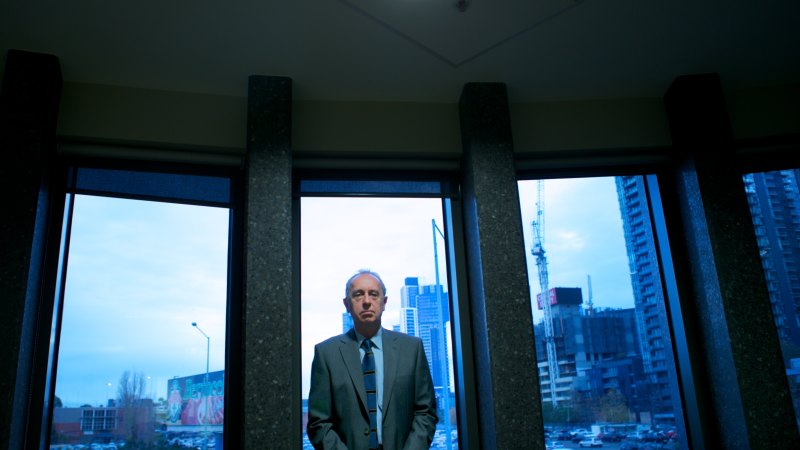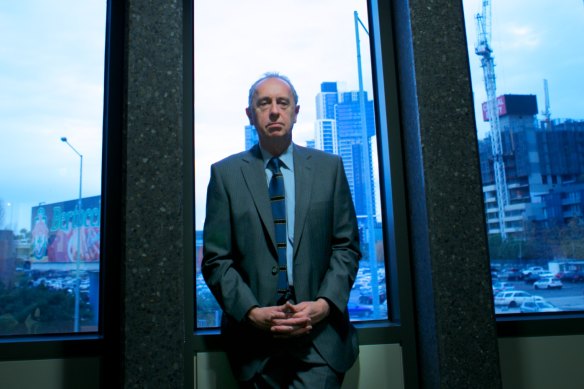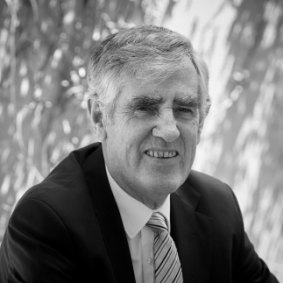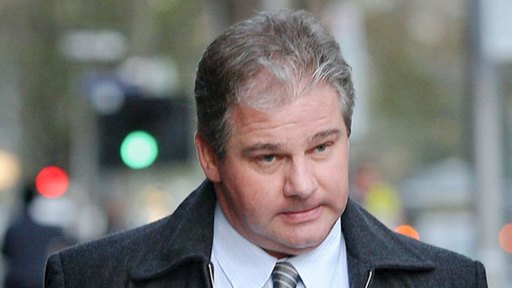Save articles for later
Add articles to your saved list and come back to them any time.
Medical specialists Professor Stephen Cordner and Dr Kerry Breen have vast experience with the justice system, and when they conclude it is time for radical change – it is time for us to listen.
Their new book, Wrongful Convictions in Australia, is written with typical scientific and academic qualifications to avoid bold assertions, but make no mistake, it is a bombshell.
Professor Stephen Cordner.Credit: Jason South
They claim innocent people are in jail for various reasons, including questionable evidence and contentious forensic testimony; that courts aren’t equipped to right these wrongs; and there is a need for a standing commission, which, according to their figures, would release around nine people a year because of wrongful convictions.
They support an inquiry into the 2010 murder convictions of Robert Farquharson, jailed for a minimum of 33 years over the 2005 drowning deaths of his children Jai, 10, Tyler, 7, and Bailey, 2, who he allegedly left to die in a dam to punish his ex-wife.
Cordner is emeritus professor of forensic medicine at Monash University and former head of the Victorian Institute of Forensic Medicine, while Breen is a physician and adjunct professor at Monash with vast legal experience. Not only do they know where the bodies are buried, Cordner probably did tests on them when they were exhumed.
They have found:
Cordner is a man of dry wit with an evidence-driven brain that leads him to tell the truth, no matter if it ruffles the feathers of colleagues. Breen is a prodigious writer prepared to question the status quo.
“I’m the talker, and he is the doer,” says Cordner.
Let’s start with a devastating case where a medical myth had profound legal and personal consequences.
In 2003, Kathleen Folbigg was convicted of killing her four children, Caleb, Patrick, Sarah and Laura, – aged from 19 days to 18 months – over 10 years.
The prosecution interpreted her diary as an admission of guilt, and medical evidence – unremarkable in each individual case – was compelling when related to the four deaths.
Folbigg served 20 years of a minimum 25-year sentence after being convicted of the murders of Patrick, Sarah and Laura, and the manslaughter of her first, Caleb, at the family’s homes.
The prosecution relied on Meadow’s Law, based on the assertion by British paediatrician Sir Samuel Roy Meadow that “one sudden infant death is a tragedy, two is suspicious, and three is murder until proved otherwise”.
Eventually, Meadow was discredited, and his evidence linked to several wrongful convictions.
Ten years after the conviction, Cordner reviewed the Folbigg medical evidence, finding “no positive forensic pathology support for the contention that any or all of these children have been killed”.
Turns out a genetic variant in Folbigg’s family meant her daughters had irregular heart rhythms that can cause death.
In June 2023, she was pardoned.
Cordner and Breen say prosecutors call “expert witnesses”, then have them testify in areas outside their expert fields, with the evidence – too often – being admitted without question.
Lindy Chamberlain was wrongly convicted of the murder of her baby Azaria, who died at Uluru in 1980, based on bogus forensic evidence.
One case they highlighted was a radiologist who, using X-rays, testified to the age of young Indonesian suspects, saying they were all old enough to stand trial over people-smuggling charges – “evidence that should have been challenged”.
Now the federal government will pay $27 million to those who were prosecuted between 2010 and 2012 who were found, despite the X-ray evidence, to have been as young as 12.
The authors argue the legal appeal system is not equipped to identify some wrongful convictions.
Doctor Kerry Breen
In general terms, the system works like this: juries are like computers. Feed in the right information and you will get the correct answer, so if there is a mistake it will be because the wrong information has been inputted. Appeals look at the trial judges. Did they accidentally mislead the jury? Did they make a mistake with the law? Did they allow or restrict important evidence that could impact the jury’s decision?
Cordner and Breen argue the merit of some questionable forensic testimony is not questioned, and many lawyers refuse to accept the need for change.
They say there is a need for a UK-style CCRC, which since 1997 has investigated more than 1000 cases, sending more than 800 back to court.
“If Australia had a CCRC, each year around eight or nine people in Australia (after all their appeals had been exhausted) would be discovered to have been wrongly convicted.”
‘The chances of disadvantaged, vulnerable groups having their wrong convictions reviewed are negligible.’
They also say that under the present system, the likelihood of a wrongful conviction relates more to the size of your wallet, the colour of your skin and the power of your supporter base, than the strength of your case.
“The chances of these disadvantaged, vulnerable groups having their wrong convictions reviewed are negligible,” they write.
In the book’s foreword, respected former High Court Justice Michael Kirby lends his considerable support behind a CCRC, questioning why we would think our justice system is superior to that of the UK, New Zealand, Norway and Canada, which have all introduced similar bodies.
“A full-time professional body with more resources, more time, more expertise and more inclined to question old ways where justified, appears to be necessary.”
The dam case
On Father’s Day 2005, Robert Farquharson was driving his three children back to his ex-partner and the children’s mother, Cindy Gambino, when his Commodore left the Princes Highway and veered right, smashed through a fence, then sank in a dam. Farquharson escaped and the boys drowned.
Robert FarquharsonCredit: Fairfax
Farquharson said he blacked out during a coughing fit. Police, using scientific and forensic evidence, said it was a deliberate act.
This is despite a doctor who had treated Farquharson saying he may have suffered from cough syncope (blackouts). The prosecution called an expert who said the condition was so remote and the science so flimsy, the possibility was discounted.
Farquharson was convicted, won an appeal, bailed (unusual in a homicide case), retried, convicted, and sentenced to life with a minimum of 33 years.
There was a similar case that did not receive anywhere near the same publicity.
On October 26, 2015, Geoffrey Ferguson lost control of his truck near Shepparton resulting in a fatal crash. He was charged with culpable driving, two counts of negligently causing serious injury and three of reckless conduct endangering life.
He was convicted when the jury did not believe that Ferguson’s chest infection, which had turned into pneumonia, caused a cough syncope.
This was despite his brother Stephen testifying he was on the phone to Geoffrey at the time and heard him suffer a coughing fit before the call went silent at the time of the crash.
The prosecution called the same sleep expert used in the Farquharson case who said cough syncope was “an extraordinarily rare condition”.
The Court of Appeal accepted that Ferguson could have suffered a cough-related blackout, set aside the verdict, and rather than order a retrial, entered a verdict of not guilty.
Cordner and Breen are impressed by a review of the Farquharson case in the book Road to Damnation by Chris Brook that highlights a series of what he says was flawed scientific evidence presented to the two juries.
“He (Farquharson) must have been the best driver, and the best planner. He picked the right point to go through a wire fence, go past trees in the dark and know the water wasn’t a shallow dam but an eight-metre quarry,” says Breen.
Cordner and Breen question the validity of some forensic evidence, including hair microscopy; shoe, tyre and footprint analysis; bite mark and gait comparison; and voice recognition, saying they “need careful scientific study”.
The authors are not alleging a dark conspiracy, but that some experts inadvertently drift out of their lanes; lawyers, judges, and juries sometimes take that opinion as fact; and courts aren’t equipped to right some wrongs.
“None of this is deliberately nasty,” says Cordner.
“In some cases, there is pressure on the police to get a result and there can be perceived pressure on forensic scientists not to let the side down,” he says.
Scientists, he says, can be asked unanticipated questions in the witness box that result in “on the fly” answers.
He suggests the experts be shown the questions so they can respond in a measured way to give juries the best chance to find the truth.
The debate on flawed forensic evidence is nothing new.
Colin Campbell Ross was convicted of killing Alma Tirtschke, 12, in 1921 after hairs on a blanket were found to have come from the victim.
A re-investigation found the forensics were flawed, and 86 years later he was pardoned. He was hanged in 1922 going to the gallows protesting his innocence.
Wrongful Convictions in Australia by Stephen Cordner and Kerry Breen was published on September 10 by Australian Scholarly Publishing.
John Silvester lifts the lid on Australia’s criminal underworld. Sign up to receive his Naked City newsletter every Thursday.
Most Viewed in National
From our partners
Source: Read Full Article








